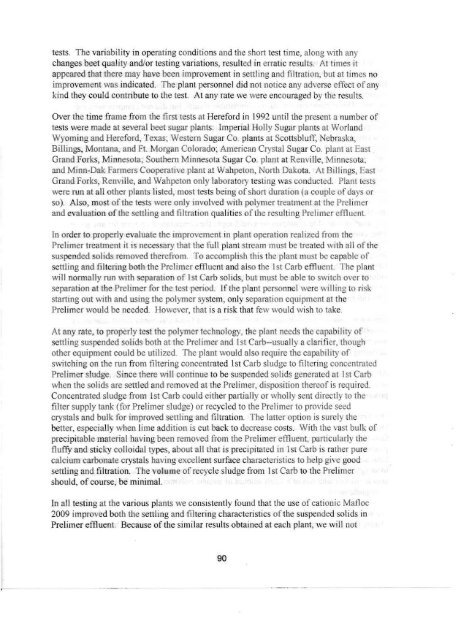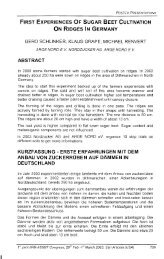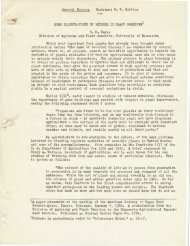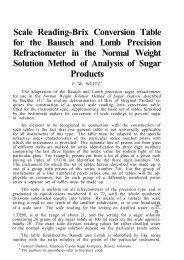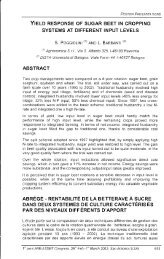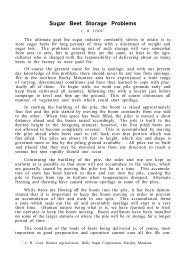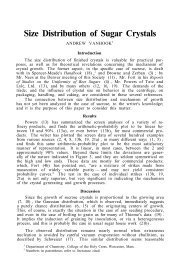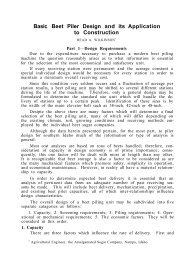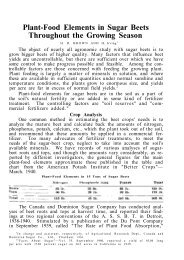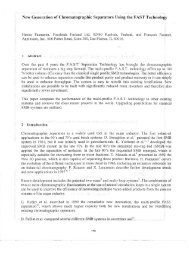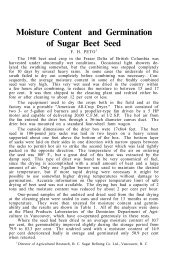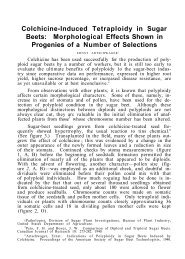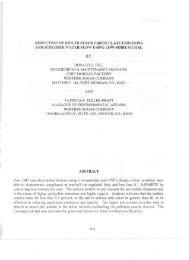Prelimer suspended solids can be separated. - ASSBT Proceedings
Prelimer suspended solids can be separated. - ASSBT Proceedings
Prelimer suspended solids can be separated. - ASSBT Proceedings
Create successful ePaper yourself
Turn your PDF publications into a flip-book with our unique Google optimized e-Paper software.
tests. The variability in operating conditions and the short test time, along with any<br />
changes <strong>be</strong>et quality and/or testing variations, resulted in enatic result . At times it<br />
appeared that there may have <strong>be</strong>en improvement in settling and filtration, but at ti mes no<br />
improvement was indicated. The plant personnel did not notice any adverse effect of any<br />
kind they could contribute to the test. At any rate we were encouraged by the results.<br />
Over the time frame from the first tests at Hereford in 1992 until the present a numb r of<br />
tests were made at several <strong>be</strong>et sugar plants: Imperial HolJy Sugar plants at Worland<br />
Wyoming and Hereford, Texas ~ Western Sugar Co. plants at Scottsbluff, Nebraska,<br />
Billings, Montana, and Ft. Morgan Colorado' Ameri<strong>can</strong> Crystal Sugar Co. plant at East<br />
Grand Forks, Minn esota ~ Southern Minnesota Sugar Co. plant at Renville, Mi nn so t~<br />
and Minn-Dak Farmers Cooperative plant at Wahpeton, North Dakota. At Billings, East<br />
Grand Forks, Renville, and Wahpeton only laboratory testing was conducted. Plant tests<br />
were run at all other plants listed, most tests <strong>be</strong>ing of short duration (a couple of days or<br />
so). Also, most ofthe tests were only involved with polymer treatment at the Preli mer<br />
and evaluation of the settling and filtration qualities of the resulti ng Prelim r effl uent.<br />
In order to properly evaluate the improvement in pJant operation realized from the<br />
<strong>Prelimer</strong> treatment it is necessary that the full plant stream must <strong>be</strong> treated with all of the<br />
<strong>suspended</strong> <strong>solids</strong> removed therefrom. To accomplish tIllSthe plant must <strong>be</strong> capable of<br />
settling and filtering both the <strong>Prelimer</strong> effluent and also the 1 st Carb effluent. The plant<br />
will nonnaJly run with separation of 1 st Carb soLids, but must <strong>be</strong> able to switch over to<br />
separation at the <strong>Prelimer</strong> for the test period. If the plant personnel were willing to risk<br />
starting out with and using the polymer system, only separation equipment at the<br />
<strong>Prelimer</strong> would <strong>be</strong> needed. However, that is a risk that few would wish to take.<br />
At any rate, to properly test the polymer technology, tRe plant needs the capability of<br />
settling <strong>suspended</strong> <strong>solids</strong> both at the <strong>Prelimer</strong> and 1st Carb--usually a clarifier, though<br />
other equipment could <strong>be</strong> utilized. The plant would al so require the capability of<br />
switching on the run from filtering concentrated 1st Carb sludg to filtering concentrated<br />
<strong>Prelimer</strong> sludge. Since there will continue to <strong>be</strong> <strong>suspended</strong> <strong>solids</strong> generat d at 1st Carb<br />
when the <strong>solids</strong> are settled and remo ed at the Preiimer, disposition thereof is requir d.<br />
Cone ntrated sludg from 1st Carb couJd either partially or wholJy sent dire tly to the<br />
fIlter supply tank (for <strong>Prelimer</strong> sl udge) or recycled to the <strong>Prelimer</strong> to provide seed<br />
crystals and bulk for improved settling and filtration. The latter option is sur Iy the<br />
<strong>be</strong>tter, especially when lime addition is cut back to decrease costs. Witb th vast bulk of<br />
precipitable material having <strong>be</strong>en removed from the <strong>Prelimer</strong> effluent, particular! the<br />
fluffy and sticky colloidal types, about all that is precipitated in 1st Carb is rather pure<br />
calcium carbonate crystals having excellent surface characteristics to help gi e good<br />
settling and filtration. The volume of recycle sludge from 1 st Carb to the <strong>Prelimer</strong><br />
should, of course, <strong>be</strong> minimal.<br />
In all testing at the various plants we consistently found that the use of cationic Mafloc<br />
2009 improved both the settling and filtering characteristics of the <strong>suspended</strong> <strong>solids</strong> in<br />
<strong>Prelimer</strong> effluent. Because of the similar results obtained at each plant, we will no<br />
90


